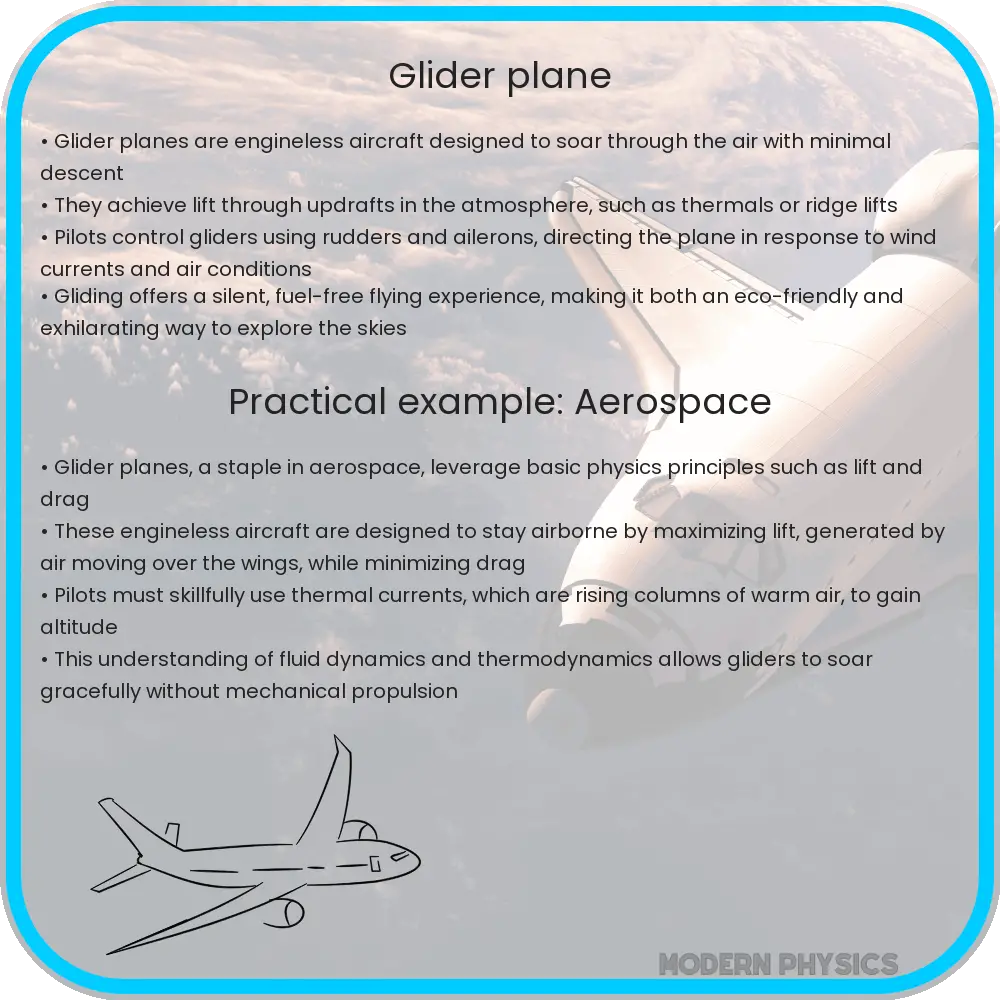Explore the fascinating world of glider planes: Learn about flight dynamics, maneuvering, stability, and advanced soaring techniques in this insightful article.

Glider Plane Kinematics: Understanding Flight Dynamics, Maneuvering, and Stability
Glider planes, known for their engine-less flight, rely on the principles of aerodynamics to soar through the sky. The kinematics of glider planes encompasses a study of their motion, including aspects like velocity, acceleration, and the forces acting upon them. This article delves into the flight dynamics, maneuvering, and stability of glider planes, providing a comprehensive understanding of how these graceful aircraft navigate the skies.
Flight Dynamics of Gliders
The flight dynamics of gliders are fundamentally governed by Newton’s laws of motion. The primary forces acting on a glider are lift, gravity, drag, and thrust (in the case of engine-assisted launch). The lift force, crucial for the glider’s ascent, is generated by the airflow over the wing. This lift must counteract the gravitational force pulling the glider towards the Earth. The equation for lift (L) can be represented as:
\[ L = \frac{1}{2} \times \rho \times V^2 \times S \times C_L \]
Where:
- \(\rho\) (rho) represents the air density
- \(V\) is the velocity of the glider relative to the air
- \(S\) denotes the wing area
- \(C_L\) (Coefficient of Lift) varies with the angle of attack
Maneuvering of Gliders
Glider maneuvering is a test of pilot skill and understanding of aerodynamics. Pilots control the glider’s direction using a combination of ailerons, rudder, and elevator. Ailerons, located on the wings, control roll; the rudder, attached to the vertical tail, manages yaw; and the elevator, found on the horizontal tail, adjusts pitch. Coordinated use of these controls enables the glider to perform various maneuvers like turns, climbs, and dives.
Stability in Gliders
Stability in gliders is critical for safe and efficient flight. There are two primary types of stability: static and dynamic. Static stability refers to the glider’s inherent tendency to return to its original position after a disturbance, while dynamic stability involves the motion of the glider after such a disturbance. The design of the glider, including wing placement, tail size, and overall aerodynamic shape, significantly influences its stability.
Understanding the interplay of forces and controls in glider planes is essential for pilots and enthusiasts alike. The next section will explore advanced concepts in glider kinematics, including thermals and cross-country soaring strategies.
Advanced Concepts in Glider Plane Kinematics
Delving deeper into the kinematics of glider planes, we encounter advanced concepts that define the art and science of soaring. These include the use of thermals, ridge lift, and wave lift, each playing a crucial role in sustaining and extending flight without engine power.
Utilizing Thermals in Gliding
Thermals, columns of rising warm air, are lifelines for glider pilots. By skillfully identifying and circling within these thermals, pilots can gain altitude. The process involves understanding weather patterns, recognizing visual cues like cumulus clouds or birds circling, and interpreting variometer readings. Efficient use of thermals allows for extended flights and even long-distance cross-country gliding.
Ridge Lift and Wave Lift
Besides thermals, gliders can also exploit ridge lift and wave lift. Ridge lift occurs when wind hits a mountain or ridge, creating an upward deflection of air. Gliders flying parallel to the ridge can use this lift to maintain or gain altitude. Wave lift, a more complex phenomenon, occurs when air oscillates in a wave-like pattern downstream of a mountain range. This can provide significant altitude gains, but requires understanding of complex wind patterns and careful planning.
Cross-Country Soaring and Glider Performance
Cross-country soaring tests a pilot’s ability to make strategic decisions based on weather conditions, terrain, and glider performance. Pilots must balance between gaining altitude in lift zones and gliding downwind to the next source of lift. The performance of a glider is often measured by its glide ratio, indicating how far it can glide for every unit of altitude lost. Modern gliders can have glide ratios exceeding 50:1, allowing for impressive cross-country flights.
Conclusion
The realm of glider plane kinematics is a fascinating blend of physics, meteorology, and skill. Understanding the dynamics of flight, maneuvering techniques, and stability factors provides a solid foundation. However, mastering gliding also involves appreciating the subtle interplay between the glider, the environment, and pilot decision-making. From thermals to ridge and wave lifts, each element offers unique challenges and opportunities. Cross-country soaring, as the ultimate test of these skills, exemplifies the beauty and complexity of glider flight. Whether for recreational purposes or competitive flying, the world of glider planes offers an enriching and exhilarating experience, showcasing the elegance of flight in its purest form.
